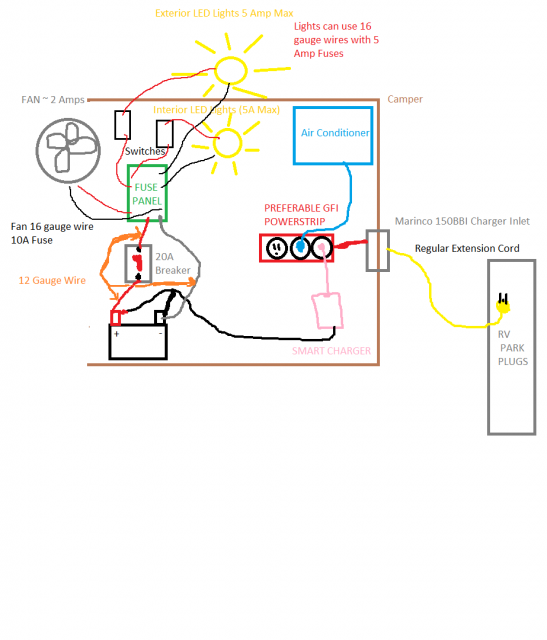I am not an electrical engineer or electrician this is just my grasp on the subject. Use at your own risk. Some campgrounds may not let you hook up electrical if you don't have a special plaque saying that your camper was built to codes
Please let me know if I messed up so I can edit my post to prevent others from making mistakesI do not know anything electrical.
Be careful electrical is one of those things where the hardest thing to know is what you don't know.
For the most part DC 12V (like a car or boat) is not dangerous except it can cause fires or burn you (mostly in short circuits)
Also batteries if short circuited, overheated, or certain types near ignition sources can explode covering everything with chemicals including acids
120V AC(household style)
is dangerous because it can electrocute you, cause fires, and burn you.
With electrical you have a couple of things and they can kind of be related to plumbing.
Voltage measured in Volts (This is equal to pressure in a plumbing system)
Voltage can either be pretty much constant (Direct Current) like in your car where its 11-14.5 Volts or it can be Alternating like household electricity which switches between +120 to -120 Volts and back to +120 60 times a second
Current measured in Amps (This is how much flow is in the system)
Resistance measured in Ohms. Resistance is generally the loads you put on the system like a fan, light, air conditioner, etc.
There is also a small amount of resistance in the wiring and that needs to be addressed to make sure your wires don't get overloaded.
These are related to each other by the formula Current = Voltage ÷ Resistance (This becomes important with wiring and fusing)
12 volt, ac dc 24 volt inverters romex etc have no clue what these things mean.
12 Volt and 24 Volt in this world are DC (Direct Current) and are like your car. They are usually supplied by a battery, solar panels, charger, AC to DC converter, or the alternator of your vehicle.
Direct Current is just a constant Voltage that causes current to flow in the same direction all the time.
You probably won't deal with 24 Volt unless you are doing solar. (It basically is just wiring two batteries or solar panels together in a certain way)
Alternating Current is what it sounds like the current switches direction (in the US 60 times a second). It switches directions because the Voltage is switching Polarity (+ or -)
Inverters change your DC (Direct Current) like a car battery to AC (Alternating Current) like in your house.
Romex is just a trade name for Non-Metallic Sheathed Cable which is the wiring in most homes. (Which again is the more dangerous AC) Its a flexible set of wires covered in a "non metallic sheath). You can pick it up at any hardware store. Due to your lack of electrical knowlodge I would recommend keeping your AC wiring as simple as possible.
I want my trailer lights to connect to the little yellow lights I have on side of build. The taillight I am using the ones on trailer
This one is relatively easy just connect them to the brown wires of the trailer harness. Ideally with solder or butt connectors covered in shrink wrap (etrailer is a good source for this info)

I want plugs like the ones at home and I have put a spot in for a small window unit run off the power at camp ground
I would keep this simple just something like this
http://tnttt.com/viewtopic.php?f=30&t=37732&hilit=electrical+diagram I would look for a GFI or GFCI power strip/splitter GFI mean ground fault interrupt and it will hopefully prevent electrocution in the event of a problem. These are like those weird plugs in peoples kitchens and bathrooms that trip if you were drop your hairdryer in the bathtub. They cost a little more but in the wet world of camping I would not skimp on it.
I want a battery with a charger to run my porch lights and inside lights and fan etc.
So this is your DC system (except the charger)
My recommendation would be to buy a smart charger (this is a cheap one
Stanley Fatmax)
you would just plug the charger into the extension cord outlets in the simple AC system above and it would keep your battery charged while you're plugged in.
Wires need to be sized for the round distance trip the electricity will need to flow as in if your fuse panel is 6 ft away from the battery it is actually 12ft of electrical wire.
DC wire sizing charts can help with this but if you keep your system simple it won't be a huge deal.

When doing the DC side you will need to keep in mind how many amps your loads will be drawing.
Once you figure out the total amps that COULD run through the wire from all the loads downstream you need to find out how long that wire will be and then pick the right gauge (thickness) wire. Once you have picked your wire size then you need to fuse the wire to the wires maximum current rating or to the slightly above the expected current draw by the appliance.
For example if you have 4 LED lights that pull 1 Amp each you would need to find a wire that could handle that current over the total wire run distance x 2.
So you have 4 lights x 1 Amp = 4 Amps total
Your total wire run from the fuse panel to the furthest light is 20 ft since the electricity has to go there and back its equivalent to 40 ft
on the wire sizing chart 4 Amps over 40ft would mean you could use 16gauge wire for the circuit.
(All of the loads you have listed would be considered non critical however when sizing the battery to the fuse box wire you should consider that critical)
Now that you have picked an adequate wire size you should fuse the wire for that wire size (16 gauge = 10 Amp, 14 gauge = 15Amp, 12 gauge = 20Amp) if the load is less than this than you could put in a smaller fuse. In our case we are only expecting 4 Amps so we would probably be fine with a 5 Amp fuse and this would make the circuit ever so slightly safer.
Hopefully I haven't totally Lost you
Here is my rough list and picture of a setup that would be similar to what you want
Summary List
Tools
Wire strippers + Cutters
Soldering Iron (optional)
Crimp Tool
Heat Gun/blow dryer (this is for the heat shrink if you're careful a lighter will work)
Electrical Tape (maybe optional) I cover exposed terminals with it
AC Side
Extension Cord (exterior rated to 20Amps) a 25 footer would probably be plenty you just need to reach the outlet at your house or campground.
Marinco 150BBI Charger inlet
GFI/GFCI splitter/powerstrip
Smart Battery Charger (8 Amps is probably good for the few loads you listed)
DC Side
Battery - if you aren't boondocking the size isn't too important. If you are then that's a whole nother rabbit hole.
Main Battery Circuit Breaker - (Probably 20A for your loads and it would keep your wire size down to 12 gauge)
Some heavy gauge wire from the battery to the Fuse panel
(probably 12gauge or 14gauge)DC Fuse Box -Some Switches or a
Switch panelsome light gauge wire sized for your loads (16 gauge will work for the loads you listed)
Some crimp connectors with shrink wrap
(kits like these can be helpful)A crimping toolobviously your 12V lights and fans
some wire holders to keep things neat and tidey.
Probably some electrical tape
Here is a rough diagram

It actually wouldn't hurt to put in a circuit breaker or fuse between the battery and charger that's maybe twice the Amps that the charger could put out.
DC wiring has a positive wire and a negative wire coming from each side of the battery. Touching these together with out an accessory in between is a short circuit and will cause blown fuses or if its not fused properly a melted wire as the wire will become the "weakest link".
The colors of the wires are a bit weird in an RV/Camper
In general for a car red is positive and black is negative
In an RV/Camper Black is positive and White is negative
I used the car color code in the diagram because I was an automotive technician for years. It can sometimes be easier to source automotive red/black wire than black/white. As long as you don't hook negative to positive you can use whatever colors you want but keep it consistent and make a diagram so your not swearing at yourself if there is a problem and if you ever get rid of it the next guy will be able to troubleshoot.
Summary again
AC is dangerous keep it simple
DC Make sure everything is fused to wire size and have a circuit breaker as close the the battery as possible.
If you think you don't know ask.




